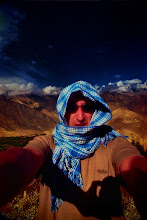Wednesday 12 August 2009
INDIA
Dalhousie
I heard a morning Qawali song on my way out of Dalhousie. A soft one with no percussion it was just a sad voice and harmonium. It was coming from the town hung on the steep slope. One could here it over the scarps of the mountain range.
The journey from Pathankot to Dalhousie leaves the Indian hot and arid plain through a sudden change of landscape to a rather steep climbing until we reach 2000m. I could see the immensity of that southern plain and also its dryness, according more to the general idea of Indian terrain. That contrasting rupture with the appearance of fertile foothills turning into high mountains marked the beginning, the birth of the Himalayan range. On the way up the landscape was turning into dark green alpine forests, a relief from the heat of the dust of the Punjabi desert, as if somebody was finally taking that hot burden off from my shoulders.
We halted for a while at Dunera, a tiny spot on the way. Not much were seen over there just a nice impression of orange juices and chili seeds among the street vendors.
There were local Christian nuns on the bus, a rarity in those places. I remembered crucifixion and the blood in the palms, Christians were burning and lute solos were heard. When the boys asked his whereabouts, they replied he was foolishly, playing with betel nuts.
The old colonial British houses looked like to be filled with ghosts and spider webs, maybe rats and corroded chains. Some abandoned in a dirty advanced state of putrefaction.
Some bloke grabbed me by my harm at the station and brought me to a rather nice slump where I would come to stay for a few days. Good deals can be made in wintertime during the touristic off-season, I was given a veranda with views to the scarped alpine slopes, and more interesting with chairs.

It´s really happening at exactly the same time in a faraway place, I always thought it was a tale you read on books or see in movies, but it´s really happening, living several infinities of realities at the same time.
During the first hours in Dalhousie, I fell into what I call the traveler´s dilemma, the stupid question "what am I doing here?" was constantly bursting into my mind.
Early the next morning I had the answer, from Ghandi Chowk right from the middle of the square, I could see the horizon line, the snow capped summits of the Pir Panjal forming a natural barrier hiding Kashmir and Jammu.
Those mythological gardens stood forbidden to me (and others) because of the political cul-de-sac created after the bloody partition. Indian TV used to show killings in their news everyday, four, five separatists down today, their dead corpses lined up at the boots of soldiers in turbans. I remarked only one percent of this information about the war in Kashmir was getting to the West. Nonetheless, everyday...
From Gandhi Chowk the Pir Panjal and the Himalayan system appears in an almost 180 degrees panoramic view which made those tired thoughts of mine, vanished completely. The Himalayan peaks of snow in the morning light were just presenting all their majesty and true beauty before my sight. What hidden gardens and stories of death were to be seen and heard in those secret valleys?
In Dalhousie, there are colored religious Tibetan low-relief carved paintings on the rocks along the way to Subbash Chowk, Padmasambahva and other Buddhas and heroes amidst the hordes of wild monkeys in the trees.
The Tibetans have a market at Gandhi Chwok that looks like a cave or a tunnel. Their exile in a foreign land have probably made them hide from the sun.

In the nomad´s tent I saw a huge crowd of Tibetan monks, the Kashmiri Muslim coolies with ropes on their shoulders and Hindu women dressed up in saris, wrapped in a Indian shawl, I saw them vanishing in a mirage.
There was a graffiti on the Pathankot´s station's walls that said "Read Vedas". A poster of the Revolutionary Students was hanging underneath one of the rightist party. On the poster you could read "The world is ours".
And then with a speech of the size of the universal soul and a voice like thunder, the beggar guiding with both hands on his shoulders the sick boy with Christmas garlands at his forehead, and dressed up like a holy man, burst before me like some kind of vision from another world. The boys were turning into holy men and the saddhu was just an arrogant beggar.







